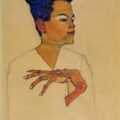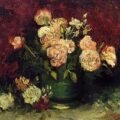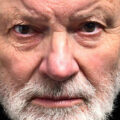A Local Habitation and a Name: On Luke Fischer’s A Gamble for My Daughter

Luke Fischer, among the hardworking and intelligent poets working today, belongs to a rare subculture of modern poets that are truly Orphic. Equal parts philosopher and poet, in the last nine years he has published three books of poems—Paths of Flight (Black Pepper, 2013), A Personal History of Vision (UWAP, 2017), and now A Gamble for My Daughter (Vagabond, 2022)—and three works of philosophy. A Gamble for My Daughter coincides with the publication of his co-edited volume The Seasons: Philosophical, Literary, and Environmental Perspectives (SUNY, 2021) and follows upon another co-edited collection, Rilke’s Sonnets to Orpheus: Philosophical and Critical Perspectives (Oxford UP, 2019), which is itself a continuation of his first foray into poetic philosophy, The Poet as Phenomenologist: Rilke and the New Poems (Bloomsbury, 2015).
This catalogue of Fischer’s work is a good index of the themes that animate A Gamble for My Daughter: his poems combine the first-person phenomenology and careful personal observation of Personal History with the ecological “poetic phenomenology of the seasons” that is his focus in The Seasons and the mystical Orphism that Fischer finds in Rilke. Fischer’s claim about Rilke, that his “esoteric conception of the unity of life and death achieves a certain culmination in the Sonnets, and . . . the terse compressions of the poems’ symbols and images require an esoteric understanding for their decipherment” applies equally well to himself.
The first of the collection’s three sections, “Orphic Elegy,” is prefaced by epigraphs from Proclus and Celan, preparing us for the unironic mix of Platonism and twentieth-century German poetic sensibility that one will find throughout the book. The poems in this opening section attempt to deliver on the Proclus epigraph: “All the Greeks’ theology is the offspring of the Orphic mystical doctrine.” The first poem, perhaps the most ambitious in the book, directly addresses Orpheus in the Rilkean manner:
You who were adept in death already in “this” life, who overcame death through the resonance of strings you deftly plucked, their magical combination, and your words, the way you uttered them, sang: who set free harmonics locked in the texture of each living being and of rivers, stones, clouds, stars…; in the shaped breath of consonant and vowel spoke the word-image of each thing’s origin and its place in a vast tableau like frescoes lining the interior of a temple imparting a single story. Like a voice that gives form and substance to wintery air, you sang the image before it froze into the world.
The seemingly casual free verse—unrhymed lines alternating in length and rhythm—contains numerous subtleties, such as the opening line’s punning description of Orpheus as “adept,” nodding towards the tradition of him as a magus. The repetition of “death” points to one of the key themes of book, “deftly” in line three exploits the etymological union of dexterity and gentleness, and the “voice that gives form and substance / to winter air” nods to Shakespeare’s definition of the poet in A Midsummer’s Night Dream, while altering, Platonizing and adding deathly cold to the original: “The poet’s eye, in a fine frenzy rolling, / Doth glance from heaven to earth, from earth to heaven. / And as imagination bodies forth / The forms of things unknown, the poet’s pen / Turns them to shapes, and gives to airy nothing / A local habitation and a name.”
Fischer’s variations are meaningful: beyond adding the chill of death, his Orpheus does not give form to a pre-existing “thing unknown” but creates the substance while creating the form. His archetypal poet is both mage and demiurge, creating the subject of the poem in the act of singing it. The remainder of this long and ambitious poem visits various incarnations of the Orphic impulse, from “the Platonic Academy” and the “bright / Tuscan field” to “Renaissance Neoplatonists” to “the twentieth century— / a second Renaissance” and finally to the poet’s attempt in the present, inspired by the archetypal poet, to weave “a dream in song.”
The book’s second section, “On the Way to Poetry,” plays on Heidegger’s famous treatise On the Way to Language as well as the philosopher’s fascination with the Presocratics. Each poem in the section begins with “On”—“On the Pre-Socratics,” “On Imitation,” “On Limbo,” and so on—as if the section were a lost treatise by Empedocles. It is unclear whether the poet or his daughter is the one on the way to poetry: “Though I play along and guide / the construction of mandalas, ruins, / shapes of impermanence, shadows / of her eternity, for me she conveys / but cannot be the way.” These lines, and the other poems of the section, suggest that the poet is undergoing a tutelage and that his daughter is the unwitting spirit of poetry itself:
It’s been said that language separates us from being, abstracts us from immersion in immediacy, but I see you dwell in the logos as a fish in the sea—an encompassing element virtually imperceptible—though as yet venturing only as far as your rock pool’s boundaries.
The arc of this middle section follows his progress from being “Outcast from the Self, exiled / from the cosmos” through Limbo (“Here is no place for hope / or nostalgia”) to the playful “Virgin Felisophia” (the figure of the Divine Feminine in the religion of cats) who patrols “the limen that joins our worlds.”
To be “on the way to poetry,” then, is also to be in a school for the soul, or the workshop for the soul’s formation.One consequence of a thoroughly Symbolist/Orphic cosmology is that all description is a species of ekphrasis. That is what happens in A Gamble, at least, especially in its eponymously titled final section. “Sculptures at an Exhibition,” an account of a Giacometti exhibit, uses stripped-down lines to described the sculptures of spiritually and physically desiccated humanity:
Flesh eaten away not by maggots and worms but by the acid of angst, the afterlife of bomb shards. The final exhibit not quite a sign of hope, a self-portrait as a lean dog walking with lowered head, limbs suggesting loops of skipping rope.
Not for the first time, Fischer’s rhythm and diction recall T. S. Eliot, though in tone and world view they could not be further apart. In this case, the figure bound to “loops of skipping rope” is reminiscent of The Wasteland’s crowd of people walking round in a ring, in this case with a noose at the end of their cosmological and ethical futility.
This poem is balanced and redeemed by one, “Blue Flower,” about a drawing by his daughter (which graces the cover as well) that reminds him of Paul Klee:
The figure dashed down in an instant—at first glance the sketch of a child in deep blue, standing upright with multiple limbs spread out, her head a spiral egg on its side— a blurred still of movement, a girl dancing in a ring around a rosie, whirling in the snow. We’re informed it’s a flower, of course! But its leaves are rungs, the blossom a vortex, a whirlpool or shell, the orbit of planets. It’s a blue ladder reaching to the stars.
In place of Giacometti’s sterile, hopeless ring is this Yeatsian dancer, “dancing in a ring” that is “a blurred still of movement.” The dancing girl is also a blue flower—a reference to the blue flower in Novalis’s Heinrich von Ofterdingen—a great-rooted blossomer that unfolds into the whole cosmos. No wonder his daughter’s drawing calls to mind Klee, a member of the mystical “Blue Rider” group of artists. Other overtly natural descriptions take on ekphrastic overtones, as in this fine passage from “Two-Sided Figure”:
A kookaburra cackles as the sun sets—a laughing Buddha of the bush, master of letting go, affirming transience such that it becomes transparent to timelessness—the brown in crest and wings matches the bark of his branch, his white breast, stratus clouds drifting by—a microcosm of the locality, complete in himself, his world.
At times the natural artifice around the poet threatens to come undone, as when he makes out “in a smudge of reef beneath translucent green / the glaring, twisted face of an Emil Nolde, / a phantom that stalks you up and down the beach.” In fact, the threat of ecological catastrophe, which is also an aesthetic catastrophe, hangs over the whole of creation, and underscores that it is a tragic performance of Shakespearean dimensions:
Now the globe theatre’s in flames, the land tremors, rolls in waves. As it’s claimed by the sea, we reach the nearest “raft”. With no more than a stand-up board and paddle how can one hold one’s centre of balance, stay upright on mountainous swells?
Hence the “gamble” of bringing his daughter into the world; that is to say, how can one with a clean conscience bring a child into a world in which “the threads of life, the vast Persian carpet / under our feet, the patterns of flight / woven in air, are coming undone.”
It is no wonder, then, that the section and the book as a whole end with “A Gamble for My Daughter.” Intentionally or not, the title evokes Yeats’s “A Prayer for My Daughter,” which begins with a similarly high-Romantic evocation of Wordsworth and Coleridge. Yeats’s hope that her “soul recovers radical innocence / And learns at last that it is self-delighting, / Self-appeasing, self-affrighting, / and that its own sweet will is Heaven’s will” is an apt description of the ethos of Fischer’s book. Just as Yeats hopes that his daughter will discover that “an intellectual hatred is the worst,” so does Fischer “aim to hold up a mirror / to your mind, an inborn morality.” Fischer’s poem and book end on a note of high solemnity:
You will have to endure the antinomy between the flame of platonic truth and the dark reality. It will feel like a cyclone is pulling you apart. In the eye of the storm three options will crystallise: compromise, complicity, the choice to survive as a shade; accedence to powerlessness, the futility of any action, the choice to plunge into the abyss; or summoning the strength to bear a soaring flame, to carry the torch even into Hades— this world’s proper name. As both the first and second are death the third is our gamble and prayer.
In this final vision, the poet’s daughter bears the responsibility implicitly carried by the audience: to become an Orpheus in our fallen world, and bear the Divine Feminine into a restored nature, which is to say one of perfect artifice (there is an epigraph from Sergei Bulgakov, and a poem that describes the Heavenly Sophia of Eastern Orthodoxy). This also has a Yeatsian resonance, but the Irish poet would not say that antinomies should be endured and then resolved—for him, as for Blake, they were the condition of life at all. Crazy Jane is another avatar of holy wisdom. Fischer is a poet of unique ambition and intelligence, with a loftier sense of the poet’s mission than any contemporary poet I am aware of.
About Jeffrey Hipolito
Jeffrey Hipolito lives and teaches in Seattle, Washington. He earned his PhD. from the University of Washington in 2001, and his work has been published in The Oxford Companion of Samuel Taylor Coleridge, Journal of the History of Ideas, and European Romantic Review.





